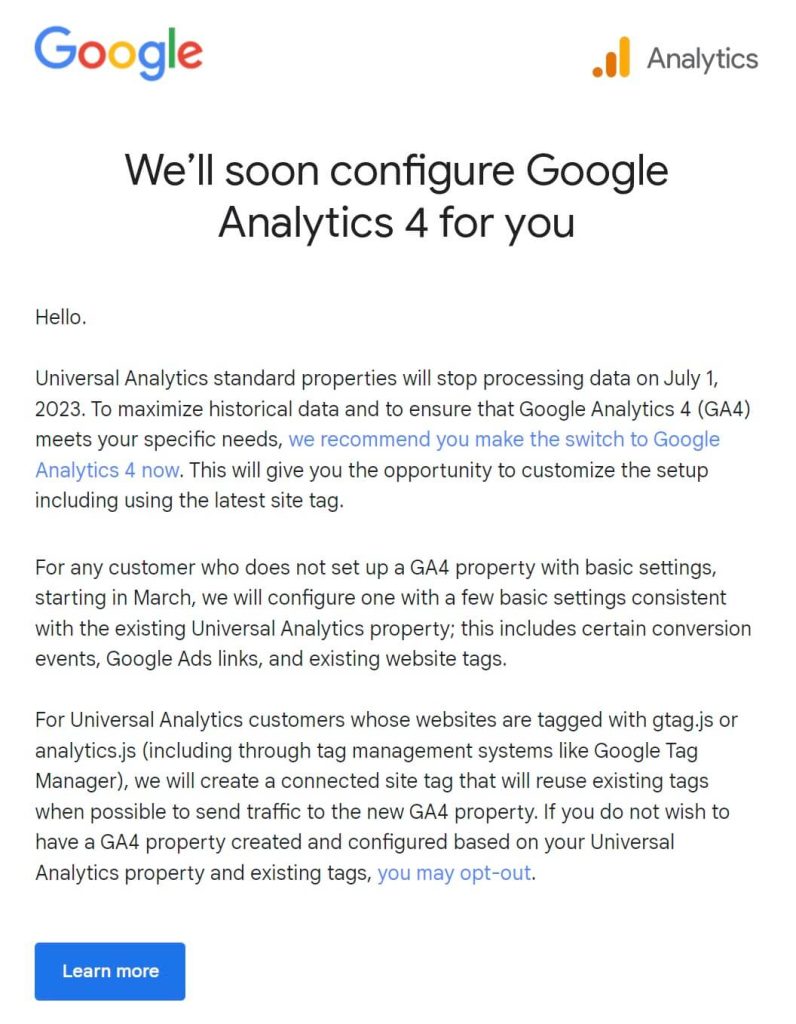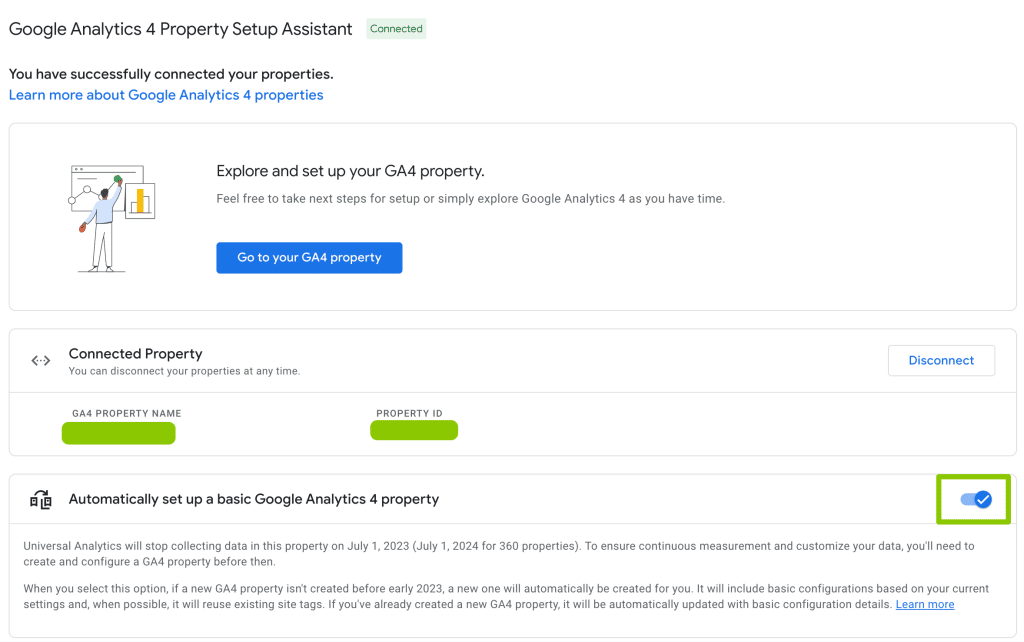If you are like many Google Analytics users, you would have received an email this past week from Google telling you that Universal Analytics is being phased out on 1 July 2023. The email also mentions that Google is planning to auto setup Google Analytics 4, even for those who may already have GA4 installed.

At first glance, we thought this was sent only to those who had set up GA4 using another account level, or not their setup assistant. However, it seems the email has been sent to everyone, or to a larger audience.
What do I do if I’ve already set up my Google Analytics 4?
Follow the steps below to opt out. You’ll need to be an ‘Editor’ or ‘Administrator’ for this to work.
You do not want another GA4 property set up that could differ from the settings you already did. Especially if you had it completed by a paid specialist.
Step 1: Login to Google Analytics at https://analytics.google.com
Step 2: Go to the analytics property you want to opt out of the auto GA4 setup.
Step 3: Click the “Manage GA4 Migration” in the yellow banner at the top of the screen. If you don’t see this banner, instead click the gear icon bottom left-hand side, and then under ‘Property’ click the “GA4 Setup Assistant” option to be taken to the next screen.

Step 4: Then go to the migration setup toggle and press on it so the toggle is switched off.

Can I let Google set up GA4 if I have not set it up already?
Google Analytics will automatically set up Google Analytics 4 in March-April if you have an existing Universal Analytics property already working for your website with active traffic in the past 12 months and you do not opt-out with the instructions above.
Google will use only the basic settings to do this. If they migrate any current goals you have in Universal Analytics, it would be a good idea to test if these are working using the debug viewer tool afterward.
Previously the Google Analytics 4 migration tool has been using event settings for page view that are not best practice. Google is only human.
So after Google has created the property, always make sure it is working. As Universal ceases to collect data from 1 July, some users may be using the old javascript tag. In this scenario, no traffic data will be captured and Google will ask that you replace your old tag with the new Google (global) tag.
What will the auto GA4 setup settings be?
Based on the information Google has provided, it is likely the basic automated settings will include:
- Your Universal Analytics property settings will be carried into your new GA4 property: industry category, time zone, and currency.
- The new GA4 property will use the same name as your Universal property but have – GA4 after the name so you can tell the difference.
- All users except “Viewer” users will be copied over to your new GA4 property.
- Your new GA4 property will attempt to use the connected site tags feature. If you have an old javascript tag, Google won’t be able to collect traffic data until you replace the tag with the Google (global) tag.
- Custom events (not to be confused with goals) will be moved across into the GA4 parameters.
- Goals will be carried over (except smart goals) into the new GA4 format. Be wary this may mean the goals may not always work and should be tested. You’ll notice the naming must be in a format like contact_submit rather than Contact Submit as an example.
- Universal Analytics audiences will be migrated across (except smart goal related).
- Your Google Ads if linked on Universal, will be linked to GA4. It means your events marked as conversions will be available to use in Google Ads from GA4 data.
- Universal Analytics audiences or properties shared with Google Ads will be replaced with GA4 equivalent.
This means that the following items are likely not included:
Some of these are not included because GA4 does not support them.
- Filters: in GA4, filters have changed. IP addresses can only be excluded from your data (unclear if they are carrying that over). Any other filters you have set up won’t work. You can consider making these as audiences though to help you manually filter traffic out e.g. based on country, pages visited, events taken by users, etc.
- Referral exclusions: we are not sure why Google has not listed this to be carried over. So in the event they do not, check your referral traffic for the past 12 months in your Universal Analytics report and identify which referral domains you don’t want to be considered as a new session. For example, afterpay.com is a payment processor for a lot of Shopify or WooCommerce sites and we don’t want them to be counted as a new session when they make a payment and return to your website.
- Data settings: In GA4 make sure to switch Google Signals on if you want Google to use its additional properties and technology to piece together users across devices (noting this data is used for audience building for Google Ads remarketing but has some limitations for sites with lower than 500 users a day.
- Data retention: change the default data retention from “2 months” to the maximum “14 months”. It means your data will be available for up to 14 months if the user does not return within that time period. Previously Universal Analytics held data with an option for no expiry date, which was not sustainable.
- Big Query: if you are an enterprise or medium-sized business, and wish to analyse data from Universal Analytics, you can export the data into Big Query to analyse later.
- Historical data: You cannot export your data from Universal to GA4 because the meausrement model has changed. To capture past data, try capturing screenshots or downloading reports for certain time periods you don’t wish to lose. We are unclear when Google will delete Universal view access and data.
- Goals: given the method has changed, whilst Google will attempt to move your goals (except smart goal as not applicable) the goal (now called an event) may not be firing correctly. So after it is set up, make sure to test it works.
- Views: Google Analytics 4 does not have a “View” feature whereby you can filter out certain traffic and create differing views. Use Audiences and the customisable reporting cards/Explorer report feature.
- Product links: we are unclear whether Google will transfer Google search console linkage as well, as they did not mention it. Also Google Adsense, Big Query, Google AdExchange etc.
- User ID: we are unsure if this will be carried over or not.
- Session settings: unclear if this will be carried over.
- Organic search sources: not carried over. To define additional organic search traffic sites (not often used as Google tends to know most).
- Search term exclusion list
- Audience: dynamic attributes, unsure if carried over with audiences.
- Custom definitions: due to the change in GA4 variable naming convention. Dimensions and metrics will need to be reconfigured.
- Data import
- Content grouping
- Channel grouping
- eCommerce settings: due to changes in data variables and collection.
- Search parameters: in most cases it is auto done in enhanced measurement settings in GA4.
- Calculated metrics
- Segments
- Annotations
- Multi-channel funnel settings
- Custom channel grouping
- Custom alerts
- Scheduled emails
- Shared reports
- Share assets
Should I let Google set up my GA4 property if I have Shopify?
If you have Shopify, you may have heard that Shopify has announced (finally) they’ll introduce a way for you to connect Google Analytics 4 to your site with an integration expected in March 2023.
The integration is expected to be a place to store your GA4 tag. It may also send data variables from your Shopify store, to then complement and feed into Google Analytics 4 new way of eCommerce measurement.
Shopify is not setting up your Google Analytics 4 property. So even though the integration is scheduled for March 2023, you are best to set up the GA4 property now to start the collection of data and get familiar with the new reporting tools.
What if I want to track specific actions on my website?
You may be familiar with the term “goals” for Universal Analytics. That’s the tool you would use to set up and track certain actions on your website. You may have also used Google Tag Manager.
In GA4, goals are no more. Events are the new goals format with extra variables than the previous event feature allowed. It means to track specific actions, you need to follow and set up the new events method. Some events such as in-site searches may already be done automatically.
If you want to set up more advanced events e.g. specific button clicks, you are best to do this using Google Tag Manager (GTM). GTM is a very techy tool and it’s best to invest in a tag specialist.
If you are a service-based business and you want to track your page views and form submissions, then you can do this easily in GA4 using the event page_view. For eCommerce, you’ll need to rely on a manual tag method, integration e.g. Shopify, or plugin e.g. WordPress has a few available.
Is it true Google Analytics will extend the Universal Analytics timeline?
Our bet is no. Google extended the timeline only for Enterprise Google 360 customers.
It comes down to the cons Universal Analytics has for Google. Universal is an old product, which would require multiple support teams for bugs and fixes. In addition, it is not compliant (more so than GA4) with GDPR laws in Europe and has a huge amount of data being stored given it had the option of no data expiry.
Why is Google Analytics shutting down Universal Analytics?
Pure speculation on our part, but we believe it is linked to the change and trend that is happening in cookie and privacy consent around the world. Mostly, around Europe and its GDPR laws.
First noticed by Apple’s privacy changes, big tech is shifting away from third-parties access to collect user information and storing it for a long period of time.
Consumers and governments are more aware and are challenging big techs’ and businesses’ ability to capture, store and use data about them.
Google Chrome has delayed cookie changes in its browser for 2 years and is expected to launch an option in mid-2024 that will stop third-party cookies from working.
A third-party cookie is a piece of code stored in your browser, which captures information about you from websites you visit after the cookie is stored. It can create a detailed profile about you from your online activities. Safari and Firefox already phased out third-party cookies which impact ad retargeting. This is the type of cookie that would result in ads showing up based on things you searched for prior e.g. you search for women’s shoes and then see ads elsewhere later for women’s shoes.
In the third-party cookie scenario, Google Analytics is not impacted.
A lot of brands, however (particularly in Europe due to the laws) added a cookie consent option to their website or via Google Tag Manager. This lets the user decide whether they wish to allow you to collect their information, including whether to track you on first-party cookie tools like Google Analytics.
It means in the future Google Analytics may be limited in how they capture certain data about a user. They will have to rely on other Google products or measurement modeling to tell you what is happening on your website. Consumers who are savvy already block website cookies.
As a result, GA4 has been designed for this problem with a greater focus on actions on pages, over just page loads like before. By creating more variables to collect events that happen on your website, you’ll be able to use and rely on first-party data in a cookie-less world.
Cookies are not going entirely as yet, just certain types will be restricted or not in use.
What are the advantages of Google Analytics 4?
- Behaviour tool: Google Analytics is a behaviour analysis tool. Whist, it won’t capture the exact same data as other sources (there is no one source of truth), it is designed to help you get a deeper understanding of your audience including how they find you online, what they do on your website and where they convert or become a lead. This level of information is often not as granular with other tools e.g. Shopify or WooCommerce reports that provide you with limited options to review your performance for content and sales. Whilst cookie consent, blockers and other challenges emerge, there’s still a place for Google Analytics to make better informed marketing and business decisions.
- Explore tool: a new and very useful analysis tool, to drag and drop what you want to measure. If you’ve not used it, now’s a good time to have a play. You can display your data in different formats including bar and pie graphs.
- Automatic events: adding scroll depth 90%, file downloads, insite search parameters and YouTube analytics into GA4 has been welcomed. Form completion (also new) is currently buggy and should be tested and switched off if not working. However, the intent is there and auto-tagged events will save you in the long run.
- Audience builder: a more advanced tool to create groups or segments, so you can build retargeting based on what people do specifically using your first-party data.
- Easy to integrate with Google products: the advantage to see Google Ads and Google search console data in analytics is what other tools often lack. Along with being able to share that data for Google advertising.
- A shift to event based modelling: Bounce rate was misleading in that it was commonly measured based on someone loading a page. Google did not really know how long someone spent on a page. But with additional event tracking, it can now measure more accurately how people consume your content.
- Google hinted that A/B testing tools are coming to GA4. This will allow you to test different web experiences and see the results to drive performance further in your online activities.
- It’s free to use.
What alternatives are there to GA4?
If you want to track your website traffic, there are other tools available like Matomo, Clicky and Smarlook to name a few. They are not immune to cookie consent trends and changes.
Given Google owns over 90% market share of online search in Australia and in most countries has the monopoly, you will likely find their tool has advantages that these others cannot provide. In addition, their tool is free (except enterprise level plans to be confirmed).
Even if you are not certain that you will use Google Analytics regularly, it does not hurt to capture the traffic data if your needs change.
How do I get help with my Google Analytics 4 setup or review?
You can hire endorsed Google Analytics expert Ray Pastoors. Explore our setup and audit options today.












